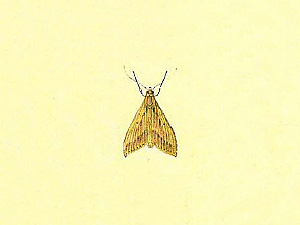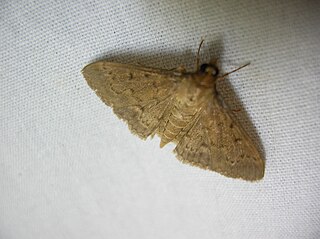Omiodes asaphombra, sometimes called the ʻohe hedyleptan moth, is a species of moth in the family Pyralidae endemic to Hawaiʻi. It was listed as possibly extinct by the United States Fish and Wildlife Service, and as extinct by the IUCN and the Hawaii Biological Survey.

Omiodes is a moth genus in the family Crambidae. Several species are endemic to Hawaii.

Omiodes continuatalis is a species of moth in the family Crambidae. It is endemic to the Hawaiian islands of Kauai, Oahu, Molokai, Maui, Lanai and Hawaii. It was first cited as possibly extinct by W.C. Gagné and Francis Gard Howarth in 1982. It was listed as extinct by the Hawaiʻi Biological Survey in 2002 and the IUCN in 2003, but was rediscovered later in 2003.

The Olaʻa banana hedyleptan moth is a species of moth in the family Crambidae. It is endemic to the Hawaiian Islands.
Omiodes fullawayi, Fullaway's banana hedyleptan moth, is a species of moth in the family Crambidae. It was described by Otto Herman Swezey in 1913 and is endemic to the island of Hawaii.
The Laysan hedyleptan moth, sometimes also known as the Laysan leafroller moth, is a species of moth in the family Crambidae. It is endemic to Laysan in the Northwestern Hawaiian Islands. It was described by American entomologist Otto Herman Swezey in 1914 based on three specimens collected from Laysan in 1912, but has not been recorded since, and may be extinct.
The Maui banana hedyleptan moth is a species of moth in the family Crambidae. It was described by Otto Herman Swezey in 1909 and is endemic to the Hawaiian islands of Molokai and Maui.

Omiodes telegrapha, the telegraphic hedyleptan moth, is a species of moth in the family Crambidae. It is endemic to the island of Hawaii.

Omiodes demaratalis, the Hawaiian grass leafroller, is a species of moth in the family Crambidae. It is endemic to the Hawaiian islands of Niihau, Kauai, Oahu, Molokai, Maui and Hawaii.

Omiodes blackburni, the coconut leafroller, is a species of moth in the family Crambidae. It is endemic to the Hawaiian islands of Kauai, Oahu, Molokai, Maui, Lanai and Hawaii. The species was first described by Arthur Gardiner Butler in 1877.
Omiodes accepta, the sugarcane leafroller, is a moth of the family Crambidae. It is endemic to the Hawaiian islands of Kauai, Oahu, Molokai, Maui and Hawaii.
Omiodes anastrepta is a moth of the family Crambidae. It is endemic to the Hawaiian islands of Oahu, Molokai and Hawaii. It was first cited as possibly extinct in 1994 by the U.S. Fish & Wildlife Service. It was listed as extinct by the Hawaiʻi Biological Survey in 2002, but was rediscovered in 2003.
Omiodes anastreptoides is a moth of the family Crambidae. It was described by Otto Herman Swezey in 1913 and is endemic to the island of Hawaii. It was first cited as possibly extinct in 1994 by the U.S. Fish & Wildlife Service. It was listed as extinct by the Hawaiʻi Biological Survey in 2002, but was rediscovered in 2003.
Omiodes antidoxa is a moth of the family Crambidae. It is endemic to the Hawaiian islands of Kauai and Oahu.
Omiodes giffardi is a moth of the family Crambidae. It was described by Otto Herman Swezey in 1921 and is endemic to the island of Hawaii.
Omiodes iridias is a moth of the family Crambidae. It is endemic to the island of Hawaii.

Omiodes localis is a moth of the family Crambidae. It is endemic to the Hawaiian islands of Kauai, Oahu, Molokai, Maui, Lanai and Hawaii.
Omiodes maia is a moth of the family Crambidae. It is endemic to the Hawaiian islands of Kauai and Oahu.
Omiodes monogona, the Hawaiian bean leafroller, is a moth of the family Crambidae. It is endemic to the Hawaiian islands of Kauai, Oahu, Molokai, Maui, Lanai and Hawaii. It was first cited as possibly extinct by the U.S. Fish & Wildlife Service in 1994. It was listed as extinct by the Hawaiʻi Biological Survey in 2002, but was rediscovered later in 2003.
This page is based on this
Wikipedia article Text is available under the
CC BY-SA 4.0 license; additional terms may apply.
Images, videos and audio are available under their respective licenses.





